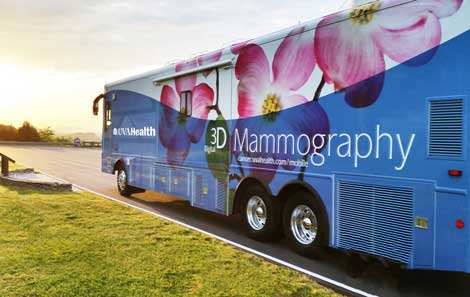Mammograms use low-dose X-rays to take a picture of breast tissue. A mammogram helps doctors find and diagnose breast cancer. It can also show the size and location of a lump before a biopsy or surgery.
When Should You Get a Mammogram?
Current recommendations advise you to, at ages:
- 30-39, have your doctor assess your breast cancer risk
- 40+, with average risk, start getting annual mammograms
- 50-74, get a mammogram every two years
Different recommendations for mammograms exist. If you have a high risk for breast cancer, you may need to start getting mammograms earlier and more often. Talk to your doctor to decide what's best for you.
Schedule a Mammogram With MyChart
You can self-schedule your mammogram using your MyChart account.
During a Mammogram
You'll stand in front of a special X-ray machine. A technician will adjust a platform on the machine. They will then place your breast on the platform between two plates. The plates will close in and compress your breast.
We'll take at least four pictures. The X-ray will get a side view and a top-down view of each breast. This takes about 30-45 minutes.
We may need to get more pictures if:
- You have breast implants
- We need them to make a diagnosis
At UVA Health, we use 3D mammograms.

Mammograms That Come to You
In the UVA mobile mammography coach, you'll find an elegant, self-contained breast cancer screening center with the latest technology. This coach brings mammograms to women at workplaces and community locations throughout Virginia. View our calendar or call to sign up.
Getting Your Results
The radiologist will look at the images during the exam. They may speak with you before you leave.
You'll get your mammogram results within 7 days, either:
- In MyChart, in the Test Results section
- By phone call, from your doctor
- In a letter, by mail
Accuracy
A mammogram can miss problems. It can also find things that look like cancer, but aren't.
If we notice something on your mammogram, you may need more tests. An ultrasound or a biopsy can provide answers.
Make Your Mammogram More Comfortable
Some people experience discomfort or pain while getting a mammogram.
To make the exam less uncomfortable, you can try:
- Scheduling the exam when breast tissue is least tender, about a week after your period
- Avoiding caffeinated drinks
- Applying skin numbing products
Make sure to tell the technician if you:
- Are pregnant
- Are breastfeeding
- Have breast implants
Also, on the day of your exam:
- Wear comfortable clothing so you can easily remove your shirt.
- Describe any breast problems to the technician before the exam.
Signs of Concern
After the test, call your doctor if you have:
- Changes in a breast, including a lump or thickening
- Skin discoloration or discharge from the nipple